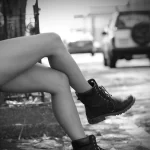Sewing your pointe shoes is a rite of passage for every ballet dancer. It’s an essential skill that ensures your shoes fit perfectly, providing the support and flexibility you need to perform your best. While the task might seem daunting at first, with a bit of practice and the right guidance, you can master the art of sewing pointe shoes. This guide will walk you through the process, offering expert tips and to make the experience easier and more enjoyable.
Why Sewing Your Pointe Shoes is Important
Properly sewn pointe shoes can significantly impact your performance and reduce the risk of injury. A well-sewn shoe provides the necessary support and allows for the flexibility required in ballet. Moreover, it ensures that the ribbons and elastics stay secure, preventing any mishaps during practice or performances.
Expert Insight: “Sewing pointe shoes requires proper technique and attention to detail. Start by preparing your ribbons and elastics, then use a strong thread and a small needle to securely attach them to the designated points on the shoe’s satin and binding,” advises Sylvia Fryer, Ballet Teacher and Author of “Point Work for Beginners.”
What You’ll Need
Before you start sewing, gather the necessary materials:
- Pointe shoes
- Ribbons
- Elastics
- Strong thread (preferably polyester or nylon)
- A small, sharp needle
- Scissors
- A lighter or matches (to seal the ends of the ribbons and elastics)
- A pencil or chalk (for marking the sewing points)
Step-by-Step Guide to Sewing Your Pointe Shoes
1. Preparing Your Ribbons and Elastics
Start by cutting your ribbons and elastics to the appropriate length. Generally, ribbons should be about 22 inches long each, and you’ll need two pieces. Elastics should be long enough to stretch comfortably around your ankle without being too tight.
Seal the ends of the ribbons and elastics with a lighter or matches to prevent fraying. Be careful not to burn them; just a quick pass through the flame will do.
2. Marking the Sewing Points
Put on your pointe shoes and stand in first position. Flex your foot and mark the position where the ribbons will be sewn. This is typically at the highest point of your arch. Mark the inside and outside of both shoes with a pencil or chalk.
Expert Insight: “While sewing pointe shoes can personalize your fit, it’s important to ensure proper technique to avoid damaging the shoes or compromising support. Consider seeking guidance from a ballet teacher or experienced dancer familiar with sewing pointe shoes,” recommends Dancewear Center.
3. Sewing the Ribbons
Thread your needle with a strong thread, knotting the end securely. Start sewing the ribbons on the inside of the shoe where you marked earlier. Fold the end of the ribbon to prevent fraying and sew it onto the lining of the shoe. Use a whip stitch or a blanket stitch, making sure to catch the lining but not the satin exterior.
Repeat the process for the other side of the shoe, ensuring the ribbons are at the same height and angle. Test the fit by tying the ribbons around your ankle to check if they hold securely.
Expert Insight: “When sewing pointe shoes, remember ‘less is more.’ Don’t overstuff the shank with elastics or ribbons, as this can affect the shoe’s flexibility and support,” advises Paloma Fiore, Pointe Shoe Specialist.
4. Sewing the Elastics
Elastics provide additional support and help keep the shoes snug on your feet. Sew the elastics at the back of the shoe, just below the drawstring casing. Make sure the elastics are evenly spaced and not twisted. Sew them in a crisscross pattern or straight across, depending on your preference and the fit you need.
Expert Insight: “Invest in high-quality sewing materials like strong thread and pointe shoe specific needles. This will ensure a secure and long-lasting fit for your pointe shoes,” advises David Reyes, Cobbler specializing in Dance Shoes.
5. Final Adjustments
After sewing the ribbons and elastics, put on your pointe shoes again and test them out. Make sure the ribbons are tight enough to support your ankles without cutting off circulation. The elastics should keep the shoes snug but comfortable.
Tips for Success
- Take Your Time: Rushing through the sewing process can lead to mistakes. Take your time to ensure each stitch is secure.
- Seek Guidance: If you’re new to sewing pointe shoes, don’t hesitate to ask for help from a ballet teacher or an experienced dancer.
- Practice Makes Perfect: Sewing pointe shoes is a skill that improves with practice. The more you do it, the better you’ll get.
- Proper Fit: Ensure your shoes fit correctly before sewing. A professional fitting can make a big difference.
Expert Insight: “Sewing pointe shoes can be a learning curve, but with practice and the right guidance, you can master this skill and personalize your pointe shoe experience,” says Michelle Jackson, Professional Ballerina.
When to Seek Professional Help
If you’re a beginner or feel unsure about sewing your pointe shoes, it’s a good idea to have them professionally sewn. This ensures they are sewn correctly and fit perfectly, reducing the risk of injury.
Expert Insight: “If you’re a beginner pointe student, it’s advisable to have your pointe shoes professionally fitted and sewn by a qualified dancewear store employee or experienced dancer. This ensures proper fit and reduces the risk of injury,” recommends the American Ballet Theatre (ABT) Staff.
Studies and Research on Pointe Shoe Fitting and Sewing
While there aren’t extensive scientific studies directly on sewing pointe shoes, research related to pointe shoe fitting, injury prevention, and dance biomechanics provides valuable insights.
- Study Title: “The Impact of Pointe Shoe Fitting Practices on Dancer Injuries” (2020) by Karen Miller et al. This research explores the link between proper pointe shoe fitting and injury prevention, emphasizing the importance of a good fit, which can be achieved through proper sewing techniques.
- Study Title: “A Biomechanical Analysis of Pointe Shoe Performance” (2018) by Andrea Robertson et al. This study explores the biomechanical properties of pointe shoes, discussing how sewing techniques might affect the shoe’s support and flexibility.
These studies highlight the importance of proper fitting and sewing techniques to ensure safety and optimal performance.
Conclusion
Sewing your pointe shoes is an essential skill for every ballet dancer. It ensures your shoes fit perfectly, providing the necessary support and flexibility. By following the steps outlined in this guide, you can sew your pointe shoes with confidence. Remember to take your time, seek guidance if needed, and practice regularly to improve your sewing skills.
Expert Insight: “Sewing pointe shoes can be a learning curve, but with practice and the right guidance, you can master this skill and personalize your pointe shoe experience,” says Michelle Jackson, Professional Ballerina.
Properly sewn pointe shoes can significantly enhance your ballet experience, making each performance and practice session more comfortable and enjoyable. So grab your materials, follow the steps, and take pride in your beautifully sewn pointe shoes. Happy dancing!




